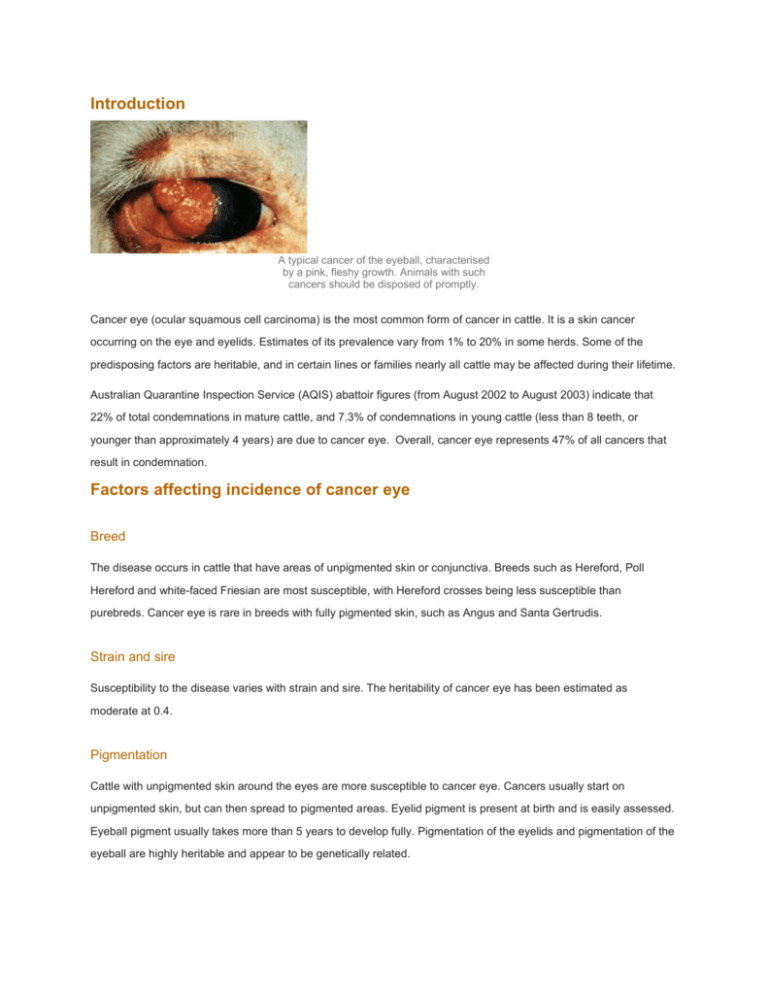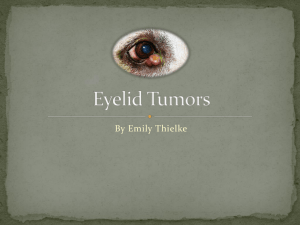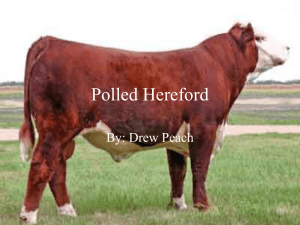cancer eye in cattle
advertisement

Introduction A typical cancer of the eyeball, characterised by a pink, fleshy growth. Animals with such cancers should be disposed of promptly. Cancer eye (ocular squamous cell carcinoma) is the most common form of cancer in cattle. It is a skin cancer occurring on the eye and eyelids. Estimates of its prevalence vary from 1% to 20% in some herds. Some of the predisposing factors are heritable, and in certain lines or families nearly all cattle may be affected during their lifetime. Australian Quarantine Inspection Service (AQIS) abattoir figures (from August 2002 to August 2003) indicate that 22% of total condemnations in mature cattle, and 7.3% of condemnations in young cattle (less than 8 teeth, or younger than approximately 4 years) are due to cancer eye. Overall, cancer eye represents 47% of all cancers that result in condemnation. Factors affecting incidence of cancer eye Breed The disease occurs in cattle that have areas of unpigmented skin or conjunctiva. Breeds such as Hereford, Poll Hereford and white-faced Friesian are most susceptible, with Hereford crosses being less susceptible than purebreds. Cancer eye is rare in breeds with fully pigmented skin, such as Angus and Santa Gertrudis. Strain and sire Susceptibility to the disease varies with strain and sire. The heritability of cancer eye has been estimated as moderate at 0.4. Pigmentation Cattle with unpigmented skin around the eyes are more susceptible to cancer eye. Cancers usually start on unpigmented skin, but can then spread to pigmented areas. Eyelid pigment is present at birth and is easily assessed. Eyeball pigment usually takes more than 5 years to develop fully. Pigmentation of the eyelids and pigmentation of the eyeball are highly heritable and appear to be genetically related. Conformation It is likely that protruding eyeballs are more susceptible than ‘hooded’ eyes, which are more protected from sunlight. Age Older cattle are more prone to cancer eye. The disease is uncommon in cows under 5 years of age. Males and females are equally susceptible, but the cancer is seen less frequently in males because steers are sent for slaughter at an early age, and bulls tend to be culled at an earlier age than cows. Nutrition It has been reported that a high level of nutrition and growth rate increases the risk of cancer eye developing. Anecdotal evidence suggests that iodine deficiency may be associated with an increased risk of cancer eye. Cancer eye is more common during and after droughts due to longer hours spent grazing in the sun, more sunlight, dust and flies, and because stress lowers immunity. Pregnancy Cancer eye often seems to develop or progress more rapidly in the latter half of pregnancy. This may be due to increased stress or the immunosuppression associated with pregnancy. It may simply be that farmers become more aware of a cancer eye when faced with the decision of whether it is humane to keep an affected cow long enough to calve and raise the calf. Virus Papillomavirus has sometimes been isolated from animals with cancer eye, but advanced virological techniques have so far failed to reveal any definite association between papillomavirus and the development of these tumours. Ultraviolet solar radiation Increased ultraviolet (UV) radiation is thought to predispose cattle to cancer eye. Therefore cattle living at low latitudes and high altitudes may be at greater risk, because latitude, altitude and daily hours of sunlight all contribute to the amount of UV radiation. Cancer eye lesions Cancer eye growths can occur on the eyeball, eyelid or third eyelid. All eye cancers develop from precursor lesions, but less than half of these lesions develop into cancer. The precursor lesion can be: a plaque (a slightly elevated, flat, opaque area on the eyeball); a papilloma (a wart-like growth protruding from the eyeball); a keratoma (a horn-like projection attached to the eyelid); a small ulcer on the eyelid. As the disease progresses from the precursor stage to the cancer stage, the tumour becomes ulcerated. Bleeding and weeping are common. Bacteria invade the lesion, which usually develops externally into a festering, foul-smelling growth. The cancerous tissue also grows inwards, invading the deeper tissues behind the eye. It can progress to the lymph nodes of the head and then to body organs such as the lungs and liver. Cancers that begin in the third eyelid or outer eyelids usually invade the deeper tissues more quickly than do those that start on the eyeball. Untreated cattle may live for 2–5 years after the first appearance of a cancerous lesion, although such cattle may become weak and emaciated within 6 months, indicating the involvement of internal organs. It is more common for only one eye to be affected, but occasionally the condition may occur in both eyes. A plaque on the edge of the eyeball. Only some of these types of lesions will progress to become tumours, and some will regress spontaneously, but it is advisable to cull such animals. Two plaques on the third eyelid. Note the poor pigmentation of the eyelids and third eyelid. A well-developed papilloma. Such lesions can be removed with a cautery by a vet, but these animals should be disposed of as soon as practicable, and not be used for breeding. Watch for horny growths around the eye — they may also turn into cancers. Welfare and sale It is regarded as an offence under the Prevention of Cruelty to Animals Act to allow cancer eye to develop to the advanced stages, and owners failing to cull such animals early enough may face prosecution. On extensive properties, where disease may become well advanced before it is detected, severely affected stock should be destroyed for humane reasons as soon as they are found. Stock with moderate to severe disease (e.g. those with tumours that are large and ulcerated or have a detectable odour) are unlikely to be accepted for transportation. They may be judged unfit for sale at the saleyards, and condemned. Such cancers can be knocked during transport or at the saleyards, and because they bleed easily, can become a gruesome sight. Animal welfare and negative public perceptions need to be considered. Animals with all but very early, non-protruding lesions should be sent directly to the abattoir if regarded as still saleable, rather than to public saleyards. If there is any evidence of spread of the cancer to nearby lymph nodes, such as lumps under the ear or jaw, the animal will be condemned at abattoir inspection. Such animals should be humanely destroyed. A good manager will inspect stock regularly, recognise the early stages of cancer eye and cull affected animals immediately. This way the animals suffer little discomfort and the carcase will usually be passed for human consumption, thus minimising financial loss. Occasionally, however, an apparently small cancer may have already spread internally, in which case the carcase will be condemned. Prevention Cancer eye can be controlled by selective breeding. Selection for pigmented eyelids is most effective and can result in rapid improvement in the herd. This selection is recommended for all Hereford herds. Selection for pigmentation around the eyes in Herefords will help prevent cancer eye. Eyeball pigmentation develops slowly, but apparently is genetically linked to eyelid pigmentation, so selection for one, in effect, selects for both. Lower-lid pigmentation is more important than pigmentation of the upper lid. The intensity of pigmentation is not important as long as it is darker than just a pale brown. Unlike eyeball pigment, third-eyelid pigment is not affected by selection for external eyelid pigment. Third-eyelid cancers account for about 10% of cancers in Herefords. They are easily removed by surgery in the early stages. Treated cows and their progeny should be culled as soon as practicable to select against this form of cancer eye. Breeders not committed to producing pure Herefords should consider crossbreeding if cancer eye is a problem. There are strain and sire differences. Breeders who identify families that are more susceptible, or sires whose progeny are more susceptible, should move away from these lines in their breeding program. Treatment Surgical treatment of cancer eye is possible, particularly in the early stages, and is warranted if, for example, a cow has a young calf. Small lesions can be removed by electrocautery (burning) or cryosurgery (freezing). A veterinarian may also surgically remove lesions from the eyelids or third eyelid, scrape a lesion from the eyeball, or remove the whole eye. In some cases, removal of very early precursor lesions may result in a permanent cure. However, more than 60% of cases recur and it is not good practice to continue to breed from treated cattle or from their progeny. An experimental vaccine made from cancer tissue to elicit an immune response has been reported to cause regression and sometimes complete disappearance of existing eye tumours, even in some moderately advanced cases. However, the vaccine is quite difficult to make, and requires large amounts of tumour material to be collected from other animals. Development of a vaccine for treatment purposes is therefore not considered to be a commercially viable proposition. Since it is undesirable to keep animals that are predisposed to cancer eye, vaccination is not recommended as a management tool, as it would make selection against the disease more difficult. Summary Eye cancer occurs in older cattle, particularly Herefords, Poll Herefords and Friesians with unpigmented eyelids and eyeballs. Control by culling animals with early signs of cancer eye. Prevent by crossbreeding or by strong selection for eyelid pigment. Never breed from affected or treated animals. Acknowledgments The original version of this Agfact was written by David Gardiner, former Veterinary Officer with NSW Agriculture. Additional information suggested for inclusion by Barbara Vanselow is gratefully acknowledged. Photos were provided by: Barbara Vanselow, NSW Agriculture Beef Industry Centre, Armidale; University of Queensland Faculty of Veterinary Science; Belinda Walker, NSW Agriculture, Gunnedah. Accessibility | Privacy | Copyright | Disclaimer | Feedback | Report a problem NSW Government | jobs.nsw








